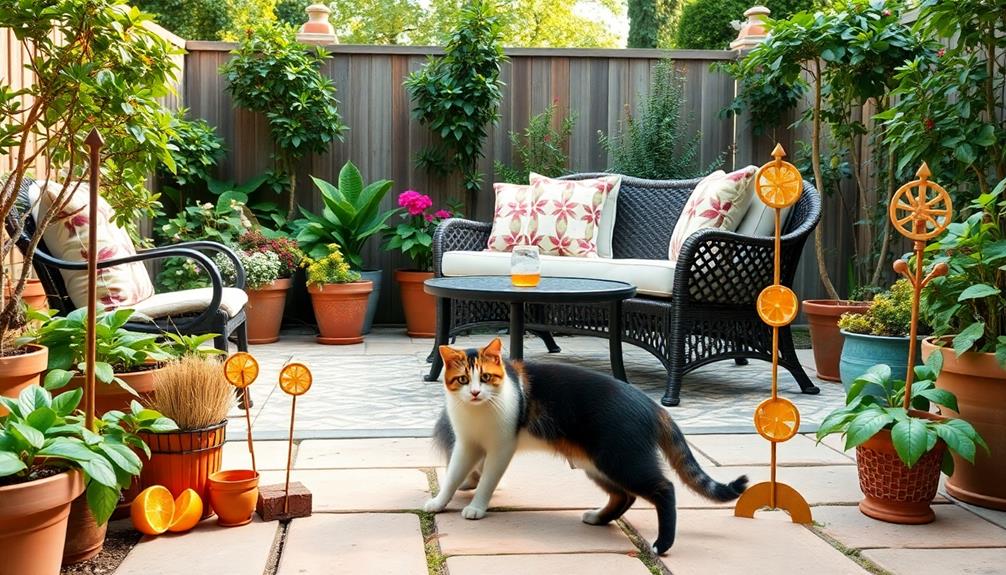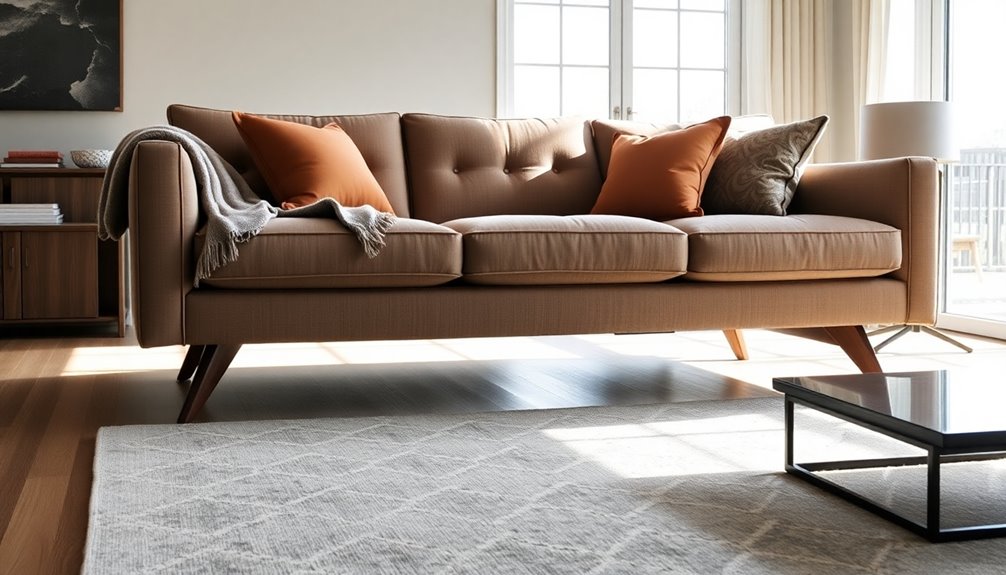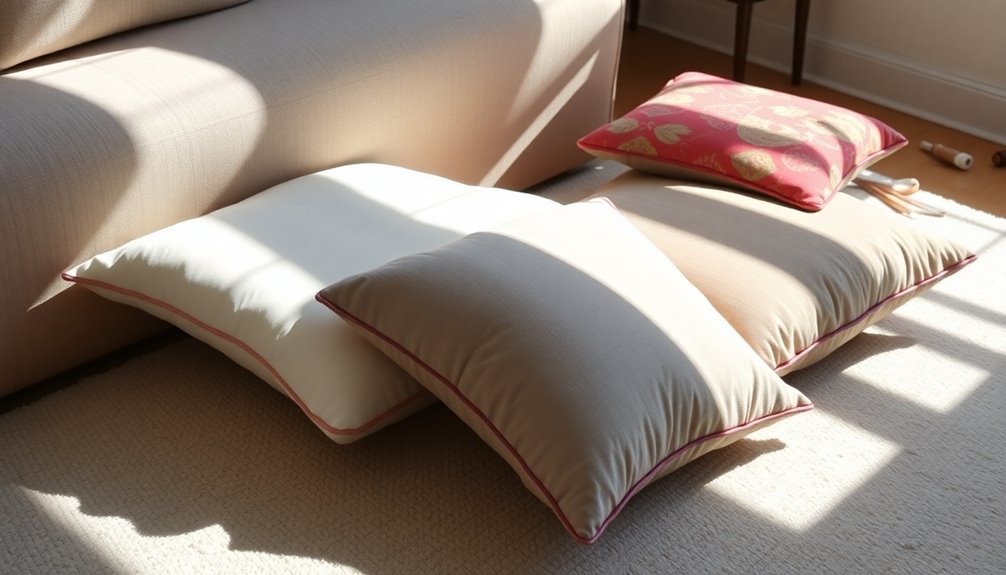In order to keep cats away from your outdoor furniture, it is important to understand what attracts them to it – warmth and a good view. Provide cozy alternatives such as pet beds or scratching posts nearby. Use natural deterrents like vinegar sprays, citrus peels, or coffee grounds to make your furniture less appealing. You can also use physical barriers like netting or decorative planters to block access. Train your cats with commands and redirection to encourage them to stay off your furniture. By making a few adjustments, you can create a more cat-free outdoor space. Continue exploring for additional tips and tricks to protect your furniture. Furthermore, offering scratching posts or designated scratching areas is essential to prevent your cats from damaging your furniture. Understanding how to prevent cat scratching involves providing attractive alternatives like sisal-covered posts or scratching pads to redirect their natural instincts. Consistently reinforcing these habits will help keep your furniture in good condition while keeping your cats happy and entertained. Additionally, using double-sided tape or aluminum foil on your furniture can also discourage your cat from climbing or scratching, as they do not like the texture. Remember to reward positive behavior with treats or praise when they use the approved alternatives. With patience and consistency, you will not only prevent your cat from scratching your furniture but also maintain a peaceful and feline-friendly outdoor space.
Key Takeaways
- Create cat-friendly alternatives like cat trees and cozy pet beds to redirect their lounging behavior away from outdoor furniture.
- Use natural deterrents such as vinegar spray, citrus peels, or coffee grounds to repel cats from furniture.
- Install physical barriers like lightweight netting or spiky mats to prevent cats from accessing outdoor seating areas.
- Train cats using positive reinforcement and consistent commands to discourage them from jumping on furniture.
- Choose pet-friendly furniture made from scratch-resistant materials and with removable covers for easy maintenance.
Understanding Cat Attraction to Furniture
Cats are naturally drawn to furniture for several reasons, making it a favorite spot for lounging and exploration. Outdoor furniture, with its soft cushions, provides warmth and comfort that cats can't resist. They love to settle into these cozy spots for sunbathing, soaking up the rays while enjoying your backyard view.
Additionally, providing proper care and attention, including a safe environment, can help keep your cats engaged in a more appropriate manner, such as through interactive playtime and suitable resting areas proper diet and care.
Furthermore, cats are instinctively attracted to elevated positions, and patio furniture offers a perfect high vantage point. From these perches, they can survey their territory, satisfying their natural curiosity.
You'll also notice your cats rubbing against furniture, leaving their scent as a way of marking their territory. This behavior is a fundamental part of their social interactions and helps them feel secure.
While you might want to keep your outdoor furniture cat-free, understanding why they're drawn to it can help you deter them effectively. You can use training techniques to repel your cats from these areas.
Consider employing scents or textures that cats dislike, as well as providing alternative lounging spots to redirect their attention. By recognizing their attraction to furniture, you can take steps to keep them off without making them feel unwelcome.
Creating Cat-Friendly Alternatives
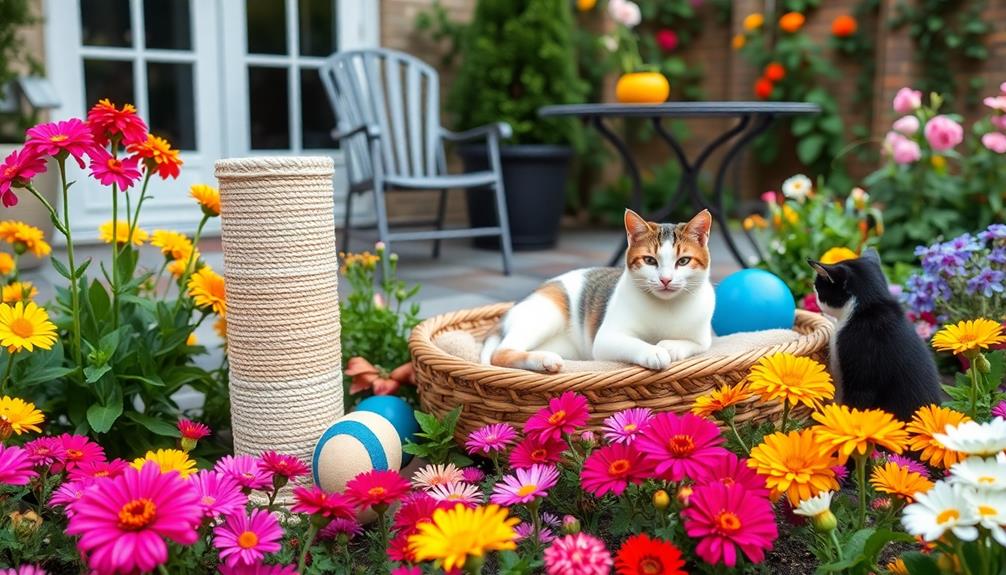
Creating a cat-friendly environment around your home can greatly reduce your feline friend's urge to jump on outdoor furniture. By offering engaging alternatives, you can satisfy their natural instincts while keeping your outdoor space intact. Here are some effective options to contemplate:
- Install cat trees or shelves near patios for designated climbing and scratching spaces, similar to how best outdoor ceiling fans enhance outdoor enjoyment.
- Provide cozy pet beds or cushions in shaded areas, so your cat can lounge comfortably without seeking outdoor furniture.
- Incorporate catnip plants or sprinkle dried catnip in specific areas, attracting your cat to these designated spots and diverting their attention.
- Offer interactive toys designed for outdoor use, keeping your cat engaged and entertained.
Additionally, creating specific play zones with scratching posts and climbing structures can redirect cats' exploration instincts away from furniture.
By implementing these strategies, you'll not only protect your outdoor furniture but also enhance your cat's outdoor experience.
With a little creativity, you can create an inviting environment that encourages your feline friend to enjoy their own space while leaving your furniture safe and sound.
Utilizing Effective Deterrents
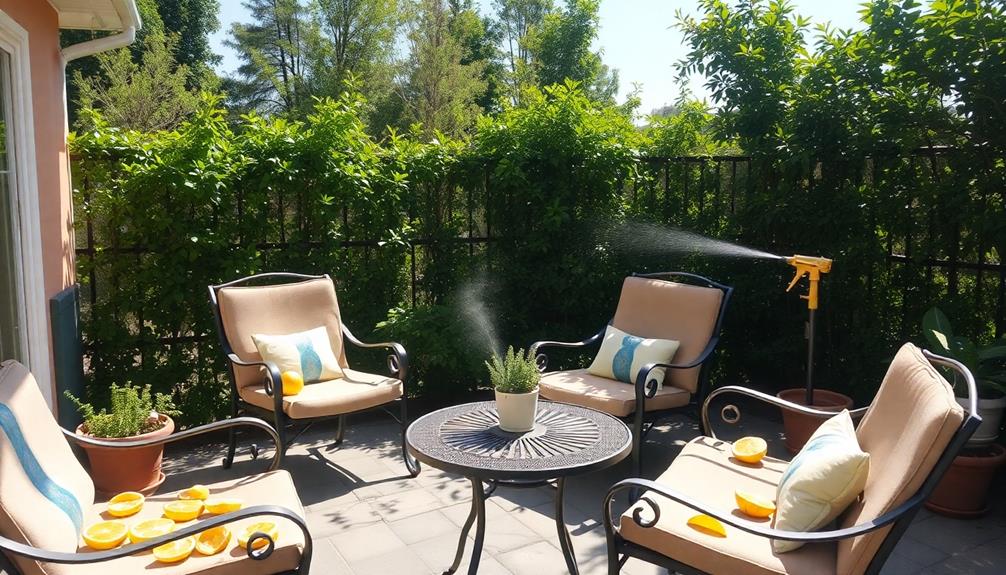
To keep your cats off the furniture, you can use natural repellent solutions and physical barriers.
Citrus scents and vinegar sprays are simple yet effective ways to make your furniture less inviting.
Additionally, you might consider offering alternative surfaces for your cats to enjoy, such as cat trees or designated scratching posts, which can help redirect their attention.
For more information on pet health considerations, ice cream and pets can provide insights into safe treat options.
Additionally, using covers or sticky tape can create a physical deterrent that cats won't enjoy.
Natural Repellent Solutions
When it comes to keeping cats off your furniture, natural repellent solutions can be quite effective. Using these methods, you can create an environment that’s less inviting to our feline friends while maintaining a pleasant space for yourself. Some effective natural repellents include citrus scents, which many cats dislike, or using double-sided tape on furniture surfaces to discourage jumping. Additionally, providing alternative scratching posts and cozy resting spots can redirect their attention. If you’re also concerned about how to prevent dog damage on sofas, incorporating similar strategies, like offering designated chew toys and using protective covers, can help create a pet-friendly home.
Here are some great options to evaluate:
- Vinegar Spray: Mix equal parts water and vinegar, and spray around your outdoor furniture. Cats dislike the strong smell, making it a great natural repellent.
- Citrus Peels: Place lemon or orange peels near your furniture. Cats tend to avoid citrus scents due to their unpleasant aroma.
- Coffee Grounds: Sprinkle used coffee grounds around your outdoor furniture. The scent of coffee acts as a cat deterrent, keeping them at bay.
- Essential Oils: Dilute essential oils like lavender or peppermint and spray them around your furniture. These scents are typically unappealing to cats.
Additionally, creating potpourri with dried citrus peels and herbs like lemongrass can enhance your outdoor space while deterring cats.
Physical Barriers and Covers
Utilizing physical barriers and covers is a practical approach to keeping cats off your furniture. Start by installing lightweight netting or chicken wire around your outdoor furniture. This creates a physical barrier that allows airflow while preventing cats from accessing the area.
When your furniture isn't in use, cover it with durable, weather-resistant furniture covers. Not only will this deter cats, but it'll also protect your furniture from scratches and soiling.
To make your furniture less inviting, consider placing spiky mats or textured surfaces on top. These uncomfortable textures discourage cats from jumping up.
Additionally, you can strategically position decorative planters or garden fencing around your outdoor seating to block pathways and limit access for curious felines.
For extra deterrence, think about using motion-activated sprinklers or ultrasonic devices. These gadgets startle cats when they approach, reinforcing the idea that the area is off-limits.
Implementing Physical Barriers
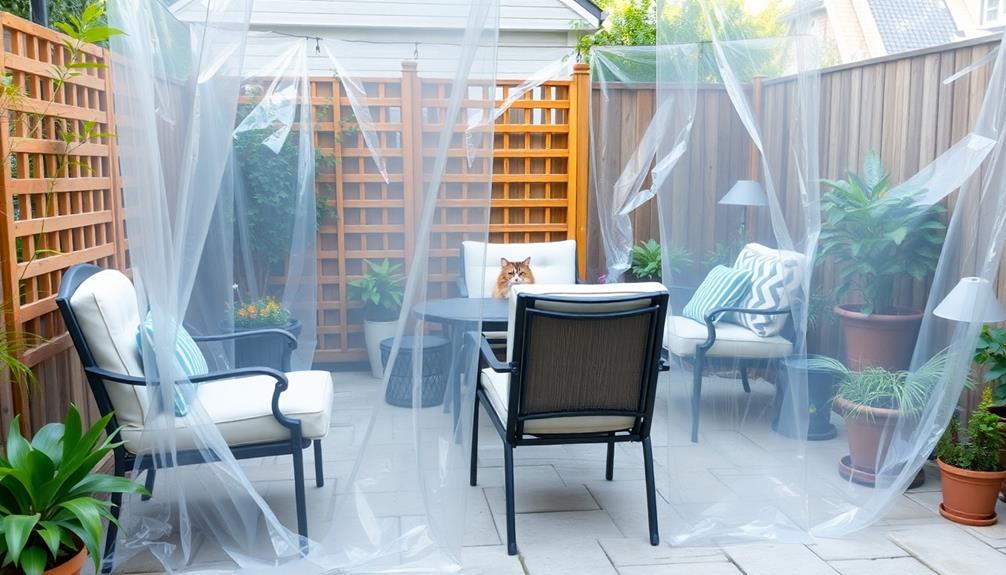
To keep your outdoor furniture cat-free, consider installing lightweight netting around it to create a subtle barrier.
Garden fencing can also define your patio's boundaries, preventing curious cats from wandering in.
Additionally, strategically placing planters can obstruct their access and help maintain a cat-free zone.
Lightweight Netting Installation
Lightweight netting acts as an effective physical barrier that can keep your outdoor furniture cat-free. To guarantee you successfully install this barrier, follow these key steps:
- Choose netting with small mesh openings: Opt for netting that has openings no larger than 1 inch to prevent cats from slipping through.
- Install at least 3 feet high: This height will discourage cats from jumping over and accessing your furniture.
- Securely fasten the netting: Use stakes or clips to keep the netting in place, ensuring it remains effective at preventing cats from getting too close.
- Regular maintenance checks: Frequently inspect the netting for any wear or damage, as maintaining its integrity is vital for continued effectiveness.
Garden Fencing Options
When it comes to keeping your cats off furniture, installing garden fencing can be an effective strategy. To deter cats effectively, choose a fence that's at least 4-6 feet tall. Cats are agile climbers, so lower barriers won't suffice. Sturdy materials like vinyl or wood are ideal, as they can withstand scratching and climbing, ensuring your fence remains intact.
Make sure the fence panels have close spacing or opt for mesh fencing to eliminate any gaps. Even the tiniest openings can entice curious felines. To further discourage climbing attempts, consider adding top extensions like slanted or curved sections. These modifications make it harder for cats to gain footholds.
Don't forget about ground barriers, either. Installing underground fencing or burying the lower edge of the fence prevents cats from digging under. Many determined cats will try to create an escape route if they sense an opening.
Strategic Planter Placement
Creating physical barriers with strategic planter placement can be a simple yet effective way to keep cats off your outdoor furniture. By arranging tall, dense planters around your seating area, you can obstruct cats' access and deter them from lounging where you don't want them.
Here are some tips to take into account:
- Use cat-repelling plants like lavender or rosemary in your planters to enhance the deterrent effect.
- Position the planters closely to the furniture to prevent easy jumping or climbing.
- Vary the heights of the planters to create an appealing visual barrier that disrupts a cat's natural path.
- Regularly maintain and rearrange the planters to keep the setup dynamic, preventing cats from getting too comfortable.
These strategic placements not only beautify your outdoor space but also form effective barriers that make it less inviting for cats.
Training Techniques for Cats
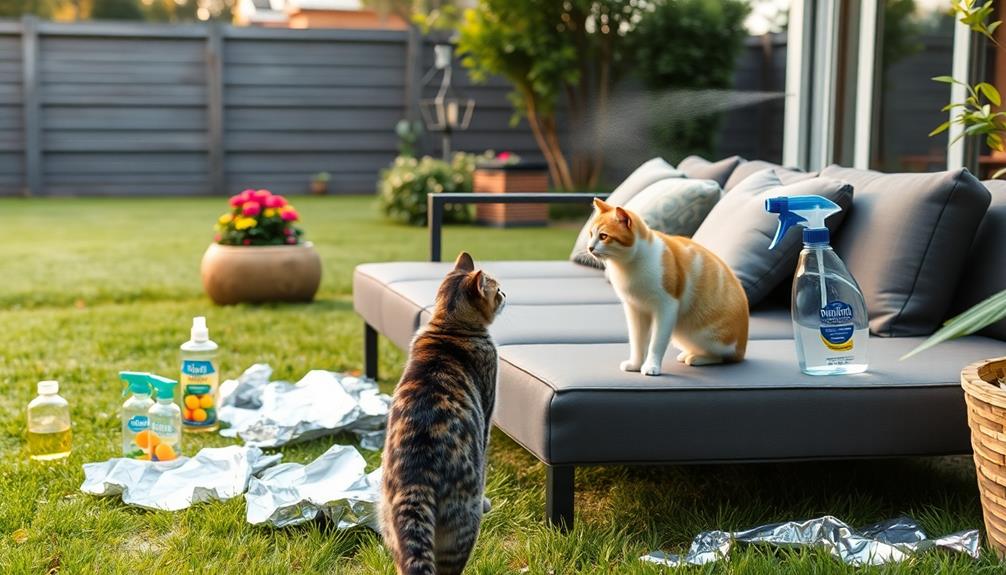
Training your cat to stay off furniture requires patience and consistency. Start by using the same commands and signals every time you catch your cat attempting to jump on the furniture. This consistency in training helps your cat understand that the furniture is off-limits.
Employ positive reinforcement to keep your cat motivated; rewarding them with treats or praise when they choose designated areas can encourage better behavior.
When you notice your cat approaching the furniture, use gentle redirection. Guide them to more acceptable spots like a cat tree or their own bed. If your cat does manage to get on the furniture, remove them immediately to create a clear association between this behavior and its consequence.
Additionally, consider using a light spray of water as a mild deterrent; however, make sure this isn't the only method you rely on.
Regular interaction and playtime can also help deter your cat from jumping on furniture by reducing boredom. By combining these techniques, you'll create an environment where your cat learns to stay off the furniture while feeling happy and engaged.
Choosing Pet-Friendly Furniture
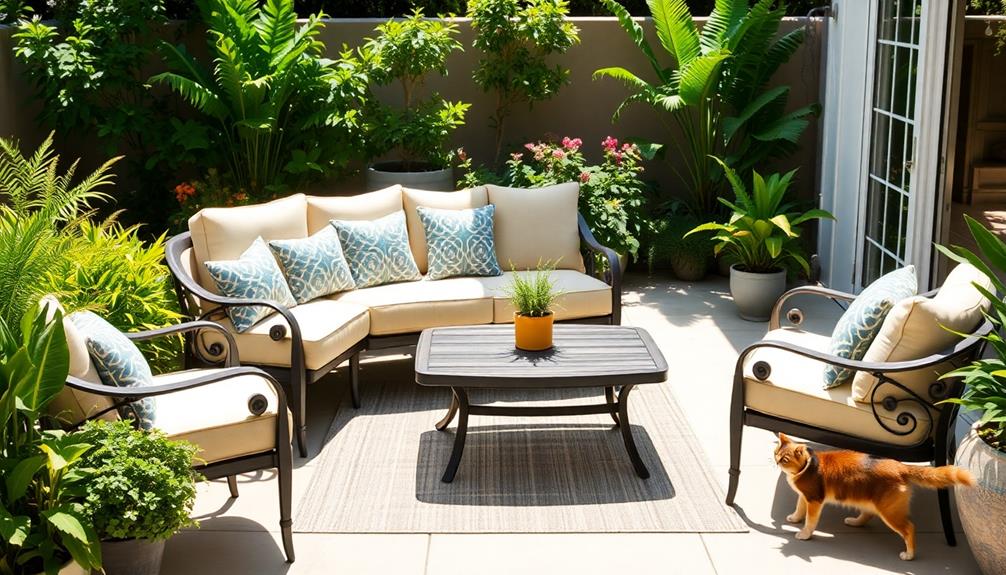
Finding the right furniture can greatly impact your efforts to keep your cat off your main seating. By selecting pet-friendly outdoor furniture, you can protect your furniture while also catering to your feline friend's needs.
Here are some key features to contemplate:
- Scratch-resistant materials: Look for rattan or metal that withstands cat claws and prevents damage.
- Removable covers: Opt for furniture cushions with machine-washable covers, making cleanup a breeze after any cat-related incidents.
- Elevated platforms: Think about furniture designs that incorporate built-in cat condos or elevated platforms. This allows your cat to enjoy their space without sacrificing your seating.
- Scratch-resistant fabrics: Choose fabrics designed specifically to resist scratching and snagging, ensuring the longevity of your outdoor furniture.
Frequently Asked Questions
What Smell Do Cats Hate to Keep off Furniture?
Cats hate strong scents like vinegar, citrus, and essential oils. You can use vinegar-water sprays, citrus peels, or diluted lavender and peppermint to keep them away. Coffee grounds also work as a natural repellent.
What Is the Most Effective Outdoor Cat Repellent?
For effective outdoor cat repellents, you should try commercial sprays like Four Paws Keep Off! Additionally, ultrasonic devices and citrus scents work well, while vinegar solutions and scented deterrents can also keep cats away effectively.
How Do I Keep Stray Cats From Peeing on My Patio Furniture?
Did you know that 70% of stray cats mark territory? To keep them from peeing on your patio furniture, use a vinegar spray, citrus peels, or motion-activated devices to deter them effectively.
What Is a Natural Cat Repellent for Furniture?
To create a natural cat repellent for furniture, mix equal parts vinegar and water, add a drop of liquid soap, or use citrus peels. Regularly reapply these solutions to maintain their effectiveness.
Conclusion
By taking these steps, you can effectively keep your cats off outdoor furniture while still creating a comfortable space for them. Some might argue that it's impossible to change a cat's behavior, but with patience and the right strategies, you can redirect their instincts. Remember, providing enticing alternatives and using deterrents can make a world of difference. Embrace the challenge, and soon you'll enjoy your outdoor furniture without feline interruptions!
